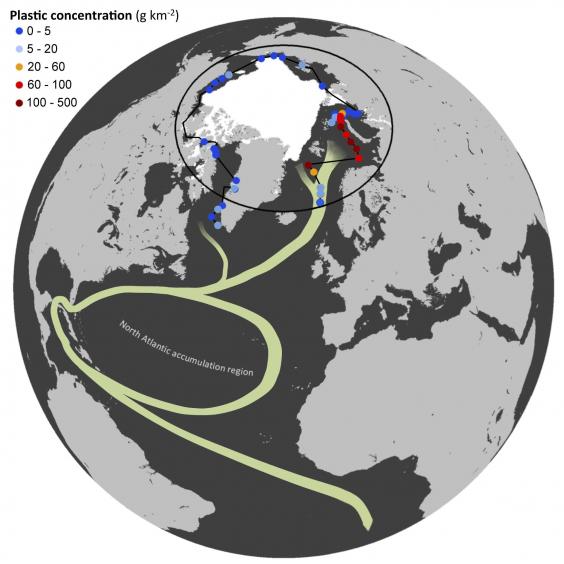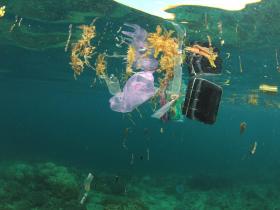http://www.independent.co.uk/environment/arctic-ocean-plastic-pieces-billions-study-a7691721.html
Once-pristine Arctic Ocean contains 300 billion pieces of plastic, study suggests
'We need to seriously consider how to drastically reduce the amount of plastic we use,' says Marine Conservation Society
- Ian Johnston Environment Correspondent
- @montaukian
- 1 comment
|
|
|
|
Click to follow
The Independent Online
The Independent Online

Hundreds of billions of pieces of plastic are floating in the once-pristine Arctic, according to a new study, in a startling indication of how polluted the planet has become.
While most Arctic waters were found to have little plastic debris, researchers discovered two major “dead ends” – in the Barents and Greenland seas – where plastic transported over thousands of miles by ocean currents has been gathering.
Other research has highlighted the dangers and the astonishing scale of the problem.
According to one estimate, there will be more plastic pollution in the oceans than fish by 2050.

The route taken by plastic pollution from the Atlantic to the Arctic (Andrez Cozar)
Plastic can contain toxic substances, but also acts like a magnet on chemicals floating in the sea, increasing their concentration to potentially dangerous levels.
Seabirds and fish, which often mistake plastic for food, can also choke to death or their stomachs can become so full of indigestible material that they starve.
The tiniest pieces of plastic are able to get into the bloodstream and even the flesh of animals. This has raised the prospect of our rubbish returning to haunt us in the seafood we eat.
In a paper in the journal Science Advances, an international team of scientists led by Dr Andres Cozar, of Cadiz University, described how they had sailed across much of the ice-free waters of the Arctic Circle, trawling for plastic.
READ MORE
In most areas, there was relatively little plastic with 37 per cent of surface net tows producing none at all, although the sampling system did not pick up items smaller than 0.5mm or the plastic microfibres produced on a large scale by synthetic clothes.
“However, plastic debris was abundant and widespread in the Greenland and Barents seas,” the paper said.
Based on their results, the researchers produced a tentative estimate of the total amount of plastic in the Arctic.
“The total load of floating plastic for the ice-free waters of the Arctic Ocean was estimated to range from around 100 to 1200 tons, with 400 tons composed of an estimated 300 billion plastic items as a mid-range estimate,” the paper said.
“The fragmentation and typology of the plastic suggested an abundant presence of aged debris that originated from distant sources.”
The most polluted areas in the northernmost and easternmost parts of the Greenland and Barents seas were found to contain hundreds of thousands of pieces per square kilometre.
The researchers said the ocean currents made each of these areas “a dead end for this plastic conveyor belt” and speculated large amounts of waste gathered there would have sunk to the sea floor.
The seas between Scotland and Iceland were identified as a “major gateway for the delivery of Atlantic plastic to the Arctic”. This stretch of water was found to have more microplastics than just off the coast of Scotland with a “significant rise” since the 1980s.
An estimated 20 tons of plastic travel along this route every year, “which would be an important contribution for the formation of a plastic accumulation zone in the Arctic Ocean”, the researchers said.
The study demonstrated the “global scale of marine plastic pollution and the role that global oceanic circulation patterns play in the redistribution of these persistent pollutants”.
“The uniqueness of the Arctic ecosystem makes the potential ecological implications of exposure to plastic debris of special concern,” the paper said.
“Plastic ingestion by northern fulmars from the Svalbard Islands, between the Greenland and Barents seas, has already been reported to exceed the recommendations for an acceptable ecological status.
“The possibility that plastic pollution affects the Arctic food web is worthy of further consideration.
Science news in pictures
“The growing level of human activity in an increasingly warm and ice-free Arctic, with wider open areas available for the spread of microplastics, suggests that high loads of marine plastic pollution may become prevalent in the Arctic in the future.”
Dr Sue Kinsey, senior pollution policy officer at the Marine Conservation Society, said it was “truly shocking” that humans had managed to pollute “every part of our oceans with plastic” in a relatively short time. Plastic has only been used on a massive scale since after World War II.
“This should be a wake-up call to all, producers, retailers and consumers alike that we have to rethink how we use plastic,” she said.
“We need to seriously consider how to drastically reduce the amount of plastic we use and design for reuse, repair and easy recycling to stop this plastic getting into the environment.”
|
|
|
|





沒有留言:
張貼留言